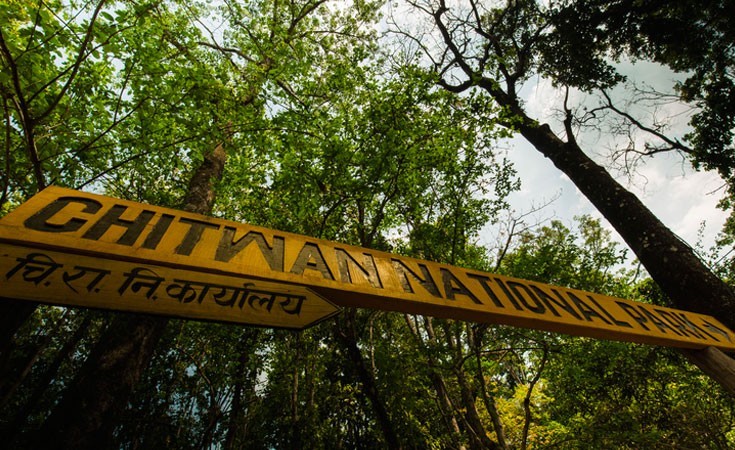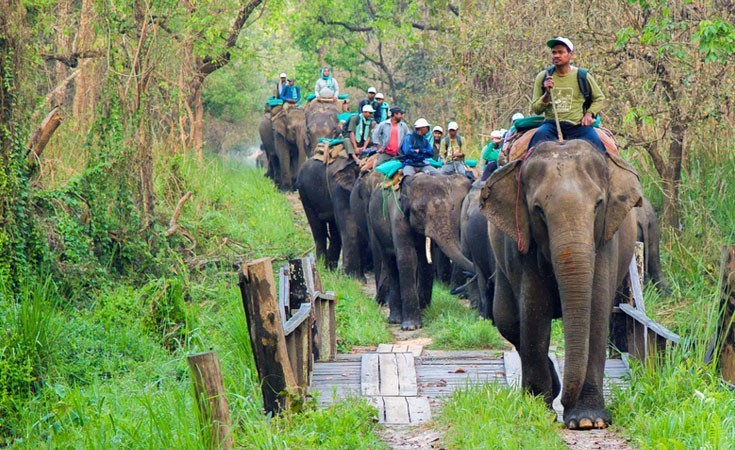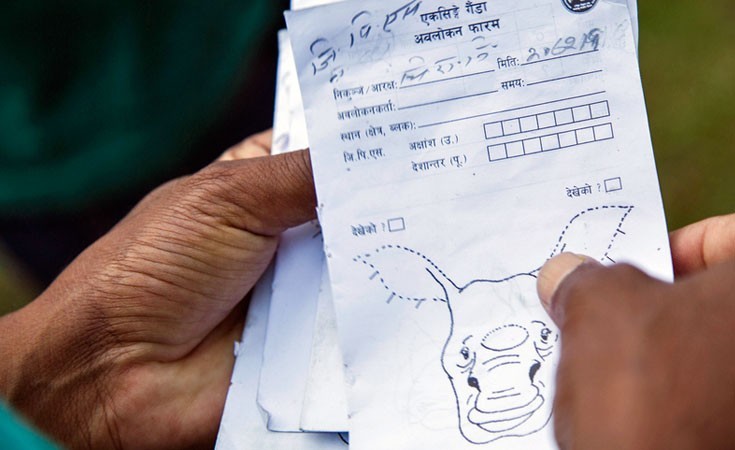
Riding High with
Nepal’s Rhinos

“It was a real privilege to spend time among people who devote their lives to the protection of Nepal’s endangered wildlife”
Richard Edwards,
head of content acquisition
It was always going to be a trip to remember. But joining a WWF team documenting Nepal’s greater one-horned rhino count ended up being an experience I’ll never forget – because of the dedicated people I met, the incredible wildlife I saw, and for more tragic reasons...
I’d been lucky enough to see rhinos in Africa, but I’d never glimpsed a greater one-horned rhino before. So I was excited to be heading to Nepal to help film and photograph these amazing animals.
After a long flight and a nerve-jangling car journey through the foothills of Nepal, the film crew and I finally arrived at Chitwan National Park. We were thrilled to meet the team from WWF-Nepal and hear that the survey was going well. We also learned that the area we’d help to survey the next day was among the most picturesque parts of the park and the best places to see rhinos.

How to count rhinos
We were up before the sun at 4.30am to check our kit, load the jeep and drive to the rendezvous point in the park. As the sun rose we were greeted by an amazing sight – a long line of elephants and their handlers, known as mahouts, emerging from the forest and lumbering towards us.

Chitwan’s stunning habitat is a mixture of tall grassland, rivers, swamps and thick forest. Surveying the entire park would be too tough for the hardiest 4x4 vehicles, and it’s too dense for an aerial survey. The only way to spot rhinos in vegetation so tall it’s known as elephant grass is… to ride on nature’s biggest 4x4 – an elephant!
As we unpacked our kit, we were told how the survey worked. The park is divided into 19 blocks. Each day a line of up to 30 elephants, with a mahout and trained observer on each, follows a transect across one of these blocks. When they see a rhino, the nearest team takes photos and makes a note of any distinguishing marks on its face, horn or ears. Then they nudge it behind the line to prevent double counting. The trick, we’re told, is to keep the line steady to ensure the whole block is covered and no rhinos are missed in the tall, thick grass. To do this, the teams rely on modern technology (GPS monitoring, mobile phone coordination) and a healthy dose of shouting by the mahouts. Data on the movement of the day’s line is recorded so the team can load it on to an interactive Google map and review it at the park headquarters that evening.

Amazing encounters
At 6am, it was time to join the day’s count. I climbed onto the back of an elephant with decidedly mixed feelings: trying to stay steady on such a magnificent beast as it traversed rivers, grasslands and thick forest wasn’t going to be easy. It’d be even trickier to hang on to any film equipment! Our survey area was 16km long and would take the best part of 12 hours – this was shaping up to be quite some challenge. But the emerging sights and sounds of the park soon had us enthralled.
After just 40 minutes, we glimpsed our first rhinos – a mother and calf next to a small thicket of forest. A few minutes later the observer next to us spotted another rhino standing proud in the long grass. Suddenly he pointed near the spot and shouted: “Baag!” I must have looked bewildered, as he quickly switched language and translated: “Tiger, tiger!” Was I really going to see a tiger within the first hour of my visit to Chitwan? I managed to see a cat-like shape leap through the tall grass, and took a quick picture before it disappeared from view. I wanted to wait for another glimpse, but we were there to count rhinos. With hearts thumping, we rejoined the line and the survey.

Over the next 11 hours we were treated to the sight of displaying male peacocks, spotted and sambar deer, brightly-coloured rollers (kingfisher-like birds), eagles snatching snakes from the grass, and almost 30 rhinos. As we returned to our survey base, exhausted but exhilarated, we were told that an incredible 130 rhinos were counted that day. We left Chitwan a few days later, proud that we’d been part of such an important survey.
The day tragedy struck
On the day we were due to leave Nepal, the first of two massive earthquakes hit the country. We were at the airport when the ground began to shake. At first we didn’t realise what was happening, then we watched in horror as large dust clouds erupted from the city below. We were the lucky ones, as after 48 hours we managed to get on flights and return home. We were relieved to hear that all WWF-Nepal staff and their families were safe, and heartened to hear that these incredibly dedicated individuals were now helping with rescue and recovery efforts.
A few weeks after the devastating earthquakes, news emerged that rhino numbers in Nepal have increased. The count recorded 645 rhinos, a 21% increase in the last five years. It’s a fantastic result, and reflects Nepal’s amazing conservation efforts. It also provided a much-needed glimmer of hope for the country.
It was a real privilege to spend time in such a beautiful part of the world, among people who devote their lives to the protection of Nepal’s national parks and their endangered wildlife. I’ll never forget my time counting rhinos in Chitwan, and my thoughts are still very much with the people of Nepal.